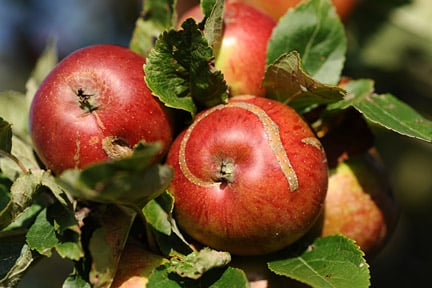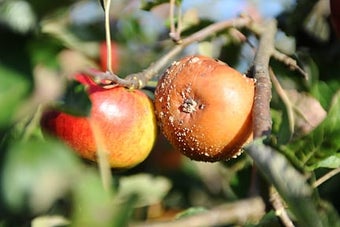
Quick facts
Common name - Apple sawfly
Scientific name - Hoplocampa testudinea
Plants affected - Apple fruits
Main symptoms - Holes in fruitlets that fall from the tree in early summer; elongate ribbon scars on mature fruits
Caused by - Caterpillar-like larvae of a sawfly
Timing - Late April-June
What is apple sawfly?
Sawflies are a group of insects suborder (Symphyta) of the Hymenoptera (bees, ants and wasps). There are about 500 species of in Britain. They have caterpillar-like larvae that feed on plant material and are named after the saw-like egg laying organ used by females to lay eggs in plant material. Adults come in a range of colours many are black, green orange or striped yellow and black. Most are small (< 1 cm) but some species such as the Birch sawfly (Cimbex femoratus) can be over 2 cm long. Several species can be found in gardens and are part of the a healthy garden will support.
The caterpillar-like larvae of initially tunnel beneath the skin of developing apples, causing a scarring, before burrowing into the fruit. Adult apple sawflies are small winged insects with blackish brown heads and thorax and brown abdomens. Images and more information on this sawfly can be found at (external link)
Symptoms
Signs of include:
- In late May and June, affected have obvious holes with the larva’s blackish-brown excrement pellets spilling out
- Each larva can feed on several fruit
- Affected fruitlets usually drop off the tree as part of the June drop (when apple trees shed excess fruits), this loss of fruits is often light and so should be tolerated
- Fruitlets that suffered only initial feeding damage by a larva can stay on the tree and develop as fruits. These fruits are usually misshapen and have a long ribbon-like scar about 4 mm wide, often starting at the eye end of the fruit and extending around the circumference. The fruit is usually still edible when this occurs

Management
The presence of can usually be tolerated and in years when there has been a heavy fruit set, a bit of caused by apple sawfly can be beneficial.
Some cultivars, such as ‘Worcester Pearmain’, ‘Charles Ross’, ‘James Grieve’ and ‘Ellison’s Orange’, seem to be particularly susceptible to apple sawfly. Apart from ‘Early Victoria’ and ‘Edward VII’, cooking apples are rarely affected.
- Where possible tolerate populations of , effect on copping is usually light and can be beneficial to a healthy crop
- Encourage predators and other natural enemies of sawfly in the garden, such as birds wasps and ground beetles
- Check apples once fruit has begun to set so action can be taken before a damaging population has developed
- Pick off damaged when they are seen to prevent the larvae moving to other fruitlets or going into the soil to pupate
Biology
Adult apple sawflies are active in late April-May and can be seen visiting the open blossom. They are 4-5 mm long, the head and thorax are blackish brown and the abdomen is brown.
Eggs are laid at the base of the flowers. After petal fall, the eggs hatch and the caterpillar-like larvae start feeding. Initially the larvae tunnel beneath the skin of the developing fruitlets. Later they bore into the core of the fruitlets, and this feeding damage causes affected fruit to drop in early summer. If the larva dies before reaching the core, the fruit can survive and develops but has a ribbon-like scar on the skin where the early feeding took place.
When fully fed, the larva is about 10mm long and has a brown head and white body. Each larva can damage 3-5 before it completes its feeding and goes into the soil, where it overwinters as a non-feeding larva and pupates in the following spring.
















